Chickpea (Bengal gram) – Qualities, Uses, Remedies, Types, Research
Dr Renita D’Souza
Chickpea (bengal gram) is a good source of protein and can add high nutritional value to your diet. Traditionally chickpea is used to treat abdominal burning sensation, enlargement of liver, mouth ulcers, inflammations, skin diseases, bronchitis, high cholesterol, flatulence, diabetes, hypertension etc. It is called Chanaka in Ayurveda and is grouped as legumes – Shimbi Dhanya Varga.
Table of Contents
Introduction
Botanical Name – Cicer arietinum
Synonyms – Cicer arientinium L. Cicer arientinum L, Cicer nigrum hort, Cicer sativum Schkuhr
Family – Leguminosae
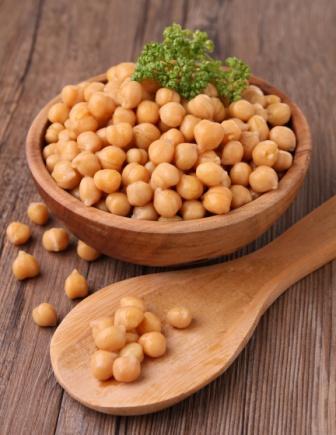
Vernacular Names
Names in Different languages
Sanskrit Name – Chanaka
English Name – Bengal gram, Chickpea, Garbanzo, Garbanzo bean, Egyptian pea
Hindi Name – Chane, Chola, Rahila, Bont
Marathi Name – Harbara, Chane
Punjabi Name – Chhole
Bengali Name – Chola
Gujarati Name – Chanya, Chana
Kannada Name – Kadle, Kadale
Malayalam Name – Kadala
Tamil Name – Kadalai
Telugu Name – Sangalu, Sanagulu
Orissa Name – Boot
Chinese Name – ying zui dou
French Name – pois chiche
German Name – kichererbse
Italian Name – cece
Portuguese Name – grão-de-bico
Spanish Name – garbanzo
Swedish Name – kikärt
Turkish Name – nohut
Medicinal Qualities
Taste – Astringent
Virya (potency) – cold
Ruksha – dry in nature
Laghu – light to digest
Vishtambi – causes constipation
Therapeutic uses of Chana
Blood diseases
Jwara – fever
Effect on Tridosha
Balances Pitta and kapha dosha
Increases vata dosha
As per Bhojana Kutuhalam twelfth chapter,the leaf of chanaka imparts taste, is hard to digest and aggravates kapha and vata. It is sour in taste and causes constipation, alleviates pitta and treats dantashotha.
Fried, boiled, steamed
Qualities of Adrabrishta (chickpea boiled in water)
Balakaro – increases physical strength
Rochana – improves taste
Qualities of steamed chickpea (Swinna)
Pittakaphaanyath – balances pitta and kapha dosha
Shushkabrishta (dry roasted chane)
Ref – Bhavaprakasha Nighantu
Ati ruksha – excessively in dry in nature
Vata prakopana – increases vata dosha
Kushta prakopana – aggravates skin disease
Roasted Chickpea (brishta chanaka)
Ref – Dhanvantari Nighantu
Laghava – brings lightness in the body
Ama hara – reduces ama (metabolic toxins)
Klama hara – reduces fatigue
Subrista Chanaka – well fried
Ref – Raja Nighantu
Potency – hot
Laghu – light to digest
Ruchya – improves taste
Vatagna – balances vata dosha
Rakta doshakrith – causes vitiation of blood tissue
Reduces kapha dosha and cold
Wet, dry, unripe
Qualities of aadra chanaka (wet chickpea)
Virya (potency) – cold
Laghu – light to digest
Ati komalo – excessively soft in nature
Ruchya – improves taste
Pitta haro – decreases pitta dosha
Shukra haro – decreases semen or sperm count
Qualities of Dry Chickpea
Chardighna – cures vomiting
Rochana – improves taste
Tejo prada – increases digestive fire
Virya prada – increases virility
Bala prada – increases physical strength
Qualities of Unripe Bengal gram
Taste – Astringent, slightly pungent
Potency (virya) – cold
Ruchikaari – improves taste
Santarpana – nourishes
Viryakaari – increases virility
Treats –
Daha – burning sensation
Trishna – thirst
Sthoulya – obesity
Ashmari – renal calculi
Black, white, yellow
Qualities of Black Chickpea
Taste – Sweet
Potency – cold
Effect on Dosha – balances pitta dosha
Balya – promotes physical strength
Rasayana – rejuvenative
Treats
Kasa – Cough
Pitta athisara – pitta origin diarrhea
Qualities of Yellowish white Chickpea (gaura chanaka)
Taste – Sweet
Balakrth – increases physical strength
Rochana – improves taste
Qualities of White Chana (svetha chanaka)
Potency – cold
Guru – heavy to digest
Ruchya – improves taste
Effect on Dosha
Balances pitta dosha
Increases vata dosha
Raja Nighantu
Qualities of Chickpea
(Ref – Raja Nighantu)
Taste – Sweet
Ruksha – dry in nature
Mehajith – used to treat diabetes and urinary disorders
Diptivarna karo – improves complexion of skin
Ruchyo – improves taste
Bala – improves physical strength
Admaana karaka – causes abdominal distention
Effect on Tridosha – increases vata and pitta dosha
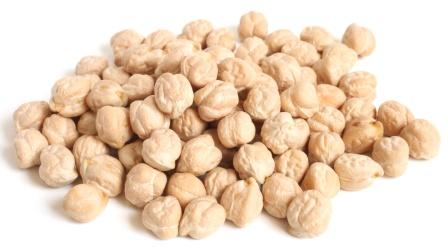
Chickpea Soup
Chickpea Soup
(ref – Raja Nighantu)
Taste – Sweet, Astringent
Reduces excess kapha dosha
Causes vata diseases
Bala – improves physical strength
Treats
Shwasa – asthma
Kasa – cough
Klama – fatigue
Pinasa – running nose
Read – Soup Of Green Gram, Chickpea And Horse Gram – Health Benefits
Chickpea salad, curry
Cooked chickpea is used as part of salad along with vegetables like cucumber, avocado, fresh parsley, etc. (recipe)
Chickpea curry prepared with tomato, onion, garlic, garam masala etc is very famous and rich in protein. (recipe)
Sanskrit Verse
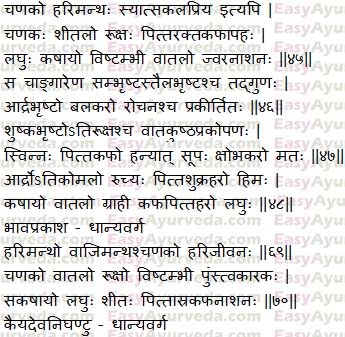
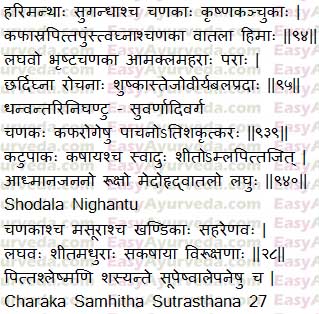
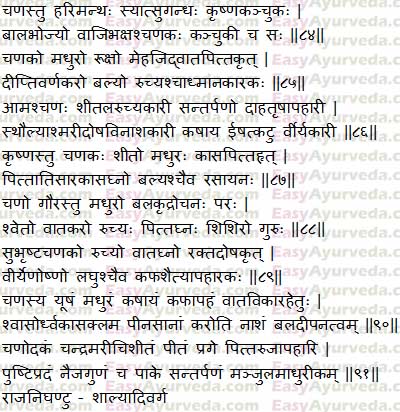
Remedies
Health Remedies of Bengal gram
For Pitta type of vomiting, associated with severe burning sensation, migrain, gastritis, water added with the chickpea flour or Gavedhuka- root or Guduchi – Tinospora cordifolia and kept to overnight can be given to the patient. – Charaka Chikitsa Sthana 20/31
Chanodaka (white chickpea soaked water)
Chickpea soaked water which is exposed to cool moon rays in the night when consumed relieves pain due to pitta dosha.
Maadhurikam (chickpea stew)
Chickpea due to its strength promoting quality it nourishes the body when consumed after undergoing proper cooking.
External use
Bengal gram powder is extensively used as body wash powder.
In infants, it is alone used as bath powder.
In adults, it is usually mixed with other skin benefiting herb powders such as sandalwood, Manjishta (Rubia cordifolia), Khadira (Acacia catechu) etc and a powder mix is prepared. The ratio of chickpea powder and herbs is 50:50.
Read related: Make your own herbal bath powder at home
In case of very oily facial skin, it is made into paste along with red sandalwood powder and water, applied over face, left for 10 – 15 minutes then washed off with water.
Chickpea powder is extensively used for preparing herbal face pack, and cleansing cosmetic procedures.
Chanakamla
Chankamla is a sour acidic medicinal preparation obtained from chickpea plant. It is used in indigestion, abdominal pain, constipation etc
These acids (malic and oxalic acid) is known to lower the blood cholesterol.
Read – Chanakamla – Chana Khar Preparation, Benefits, Dose, Side Effects
Side effects
Because it can increase Vata and Pitta Dosha, in people with sensitive stomach, it can cause stomach upset or worsening of gastritis.
It can cause bloating and gas build up. These symptoms are reduced if it is used with oil and spices.
It can trigger headache in prone people.
Interaction with medicines, supplements
Can this be used while taking Homeopathic medicine?
Yes. This product does not react with homeopathic medicine.
Can
this medicine be continued while taking supplements like multivitamin tablets,
Omega 3 fatty acids etc?
Yes. Generally, this product goes well with most
of the dietary supplements. However, if you are taking more than one product
per day, please consult your doctor for an opinion.
With western
medicines
Seek your
doctor’s advice if you are taking this product along with other western
(allopathic / modern) medicines. Some Ayurvedic herbs can interact with modern
medicine.
If both Ayurvedic and allopathic medicines are advised together, then it is
best to take Allopathic medicine first, wait for 30 minutes and then take the
Ayurvedic medicine.
Phytochemical constituents
Bengal gram contains carbohydrates, proteins, amino acids, fixed oils, phytosterols, alkaloids, phenolic compounds and tannins, flavonoids, glycosides, saponins, amino acids, iron, phosphate, sulphate and chloride
Pharmacological Activity
Bengal gram possesses Aphrodisiac, estrogenic, Antioxidant, ACE- inhibition, Anti-diabetic, Anti-inflammatory, Hypocholesterolaemic, Antidiarrhoeal, Anticonvulsant, Hepato-protective, Anticancer, Diuretic, Anti-nephrolithiasis activities etc (A)
Morphology, Distribution
Morphology
Chickpea is a bushy plant, stem grows up to 1 meter tall. Leaves are imparipinnate with 3-8 pairs of leaflets. Leaflets are glandular-pubescent, ovate to elliptic in shape, serrate margins. Pod is rhomboid ellipsoid, glandular-pubescent. Seeds are yellow, brown, black or green in color, round or angular in shape, seed coat is smooth or wrinkled.
Distribution
It is cultivated in Asia, Africa, Europe, Australia, North America and South America.
Types
1. Desi chickpea
2. Kabuli chicpea
(read related)
Research
Antihyperlipidemic activity – A study conducted to determine antihyperlipidemic activity of germinated chickpea in ovariectomy-induced dyslipidemia in rats have concluded significant antihyperlipidemic activity of chickpea sprouts.
Ayurvedic Medicines
Gentle Baby Bath – used to cleanse and hydrate baby’s skin.
Geriforte Syrup – useful in elderly people to improve immunity and to relieve stress
Kravyad Ras –
Herbofresh Bathing Powder – used in hair loss, split hair, grey hair, dandruff Acne vulgaris
Everin Bathing Powder – used in skin diseases, dandruff, hair fall, prickly heat, black heads. Give brightness and softness to skin.
Gandhak Vati – used in indigestion
Classical categorization
Bhavaprakasha Nighantu – Dhanya varga
Kaiyadeva Nighantu – Dhanya varga
Dhanvantari Nighantu – Suvarnadi varga
Raja Nighantu – Shalyadi varga
Shodala Nighantu – Shimbi dhanya varga
Sanskrit Synonyms
Chanaka, Harimantha, Sakalapriya
Vajimantha, Harijivana, Krishnakanchuka, Sugandha
Scientific Classification
Kingdom – Plantae
Division – Magnoliophyta
Class – Magnoliopsida
Order – Fabales
Family – Fabaceae
Subfamily – Faboideae
Genus – Cicer
Species – Cicer arietinum
Click to Consult Dr Renita D’Souza











8 comments
Raman
Are Bengal gram (kala chana) same as Kabuli gram (chickpeas) in their qualities?
Dr J V Hebbar MD(Ayu)Author
They are similar in their qualities.
khushwinder singh UNIVERSALIAN
Can kala chana be made tridoshoc by cooking it in pressure cooker and using ghee?
Also why dry roasted kala chana causes skin diseases?
Dry roasting adds heat element,makes it dry,heating, astringent?
Dr J V Hebbar MD(Ayu)Author
1. Yes. Adding a little bit black pepper can be good.
2. yes.
bhograz
Bengal Gram(kala chana) increases digestive fire(agni).But what is the effect of kabuli gram(white chickpea) on digestive fire(agni)?
Dr J V Hebbar MD(Ayu)Author
It can decrease Agni, increase Kapha and Vata
bhograz
Bengal gram(kala chana) increases agni(digestive fire).What is the effect of kabuli chana(chhole) on agni(digestive fire)?
Dr J V Hebbar MD(Ayu)Author
Kabuli Chana does not increase agni. It is nourishing, supports Kapha Dosha, but can increase Vata Dosha.